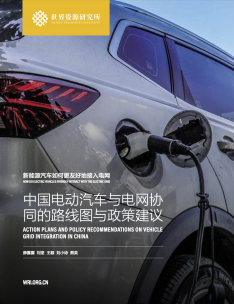Action Plans and Policy Recommendations on Vehicle Grid Integration in China
How do electric vehicles friendly interact with the electric grid series two. The widespread adoption of plug-in electric vehicles (PEV) can bring about air quality and climate change benefits. However, the concurrent, unmanaged charging of PEVs will result in surges in power loads and strain power generation, transmissions, and distribution, leading to costly public investments on grid expansions. Harnessing PEVs’ load flexibility and storage capacity, PEVs can friendly integrate into the grid system, reducing grid capacity augmentation needs. serving as grid assets and virtual power plants to support large renewable integration. Although China is lagging on VGI exploration, it has late-comer advantages. Given China’s specific electricity market mechanisms and charging standards, the research performs contextualized analysis on the economic potentials of different VGI applications along with the regulatory and technical hindrances. For VGI to thrive in China, the study proposes that regulatory, economic and technical barriers should be overcome by creating synergies among different actors.

The widespread adoption of plug-in electric vehicles (PEV) can bring about air quality and climate change benefits. However, the concurrent, unmanaged charging of PEVs will result in surges in power loads and strain power generation, transmissions, and distribution, leading to costly public investments on grid expansions.
Unlike other types of loads, vehicles’ charging loads are highly flexible in term of charging time and charging powers. Harnessing PEVs’ load flexibility and storage capacity, PEVs can friendly integrate into the grid system, reducing grid capacity augmentation needs. serving as grid assets and virtual power plants to support large renewable integration. These favorable results are achieved by deploying Vehicle Grid Integration (VGI) measures, where PEVs can smartly import electric powers from the grid (known as Managed Charging) or export electric powers to the grid (known as Vehicle-to-Grid, V2G). VGI can enable an array of services with different values from time-shifting (demand-charge reduction), distribution upgrade deferral, to frequency regulations (including primary reserve and AGC), spinning, non-spinning, and supplemental reserves, ramping supports for renewables, and the more.
According to the survey conducted by this study, China’s VGI pilots differ from global VGI pilots in many aspects. Compared to global VGI pioneers that can be traced to the early years of PEV adoption, VGI pilots in China are an only recent phenomenon. Unlike global VGI projects that focus on frequency regulation with high commercial values, China’s VGI projects mainly focus on deploying managed charging to defer distribution upgrades where the commercial viability remains unclear. Furthermore, most of the VGI pilots in China led by the National State Grid aims at testing VGI’s technical feasibility.
Renewable energy and electric vehicles are strategic emerging industries had hold great potential for coordination. Renewable energy accounts for 26.7% of China’s power generation in 2019 and will possibly increase to 51% by 2030. Among the efforts to promote renewable integration considered by Chinese government, electric vehicles can play a prominent role in demand side management and flexible grid assets. As predicted by Energy Research Institute (2017), the total storage capacity of electric vehicles will reach 250 GW and 730 GW respectively in 2025 and 2030, approximately eight and twenty-three times of the installed capacities of the stationary storage systems.
Although China is lagging on VGI exploration, it has late-comer advantages. Given China’s specific electricity market mechanisms and charging standards, the research performs contextualized analysis on the economic potentials of different VGI applications along with the regulatory and technical hindrances.
As calculated by this study, commercially, under the current regulated market regime, PEV’s participating in time-shifting would deliver the highest values to customers with 23% internal return on investments at 2020; the economic returns of frequency regulation will exceed that of time-shifting by 2030. Demand responses provide the third highest values. In recent years, the economic returns of managed charging are considerable, whereas V2G will not be commercially viable until 2030 when the costs of V2G-capable investments (on vehicles, charging points, and grid systems) and the costs of batteries begin to drop. However, PEVs in China can barely capitalize on VGI values provided by time-shifting or the revenues generated through electricity trading and third-party services, because of the regulatory and technical barriers of electricity market access.
First, lack of Time-of-Use (TOU) utility tariffs, the barriers on interconnection and access to electricity markets for distributed resources like PEVs are the main regulatory barriers to implement VGI. Although TOU tariffs can offer an effective approach to manage private PEV’s charging loads, they are often absent: cities like Beijing do not opt for residential TOU rates, and commercial tariffs are often fixed rates determined by facility owners. Furthermore, the prevailing interconnection, market access regulations, and equal allocation dispatching mechanisms are designed for large power plants and centralized stationary storages; distributed, behind-the-meter resources like PEVs face considerable entry barriers on electricity trading and third-party services. However, as China launches the electricity market reforms—piloting spot electricity markets in eight regions, these entry barriers will be removed and the economic values of VGI will be unleashed.;
Second, technically, communication standards, VGI-capable hardware, and smart battery management system are necessary preconditions to enable VGI. China’s national standard on vehicles and charging points (EVSE) communication protocol (GB/T 27930) does not support managed charging or bi-directional charging. Furthermore, the communication protocols among EVSE, charge point operators (CPO), and distribution system operators (DSO) are widely absent. Apart from communication protocols, PEV, charging points, and distribution systems also face hardware upgrade to enable load management and bidirectional electric flows. Although specific hardware upgrades are often dependent on communication protocols, some basic upgrades are always necessary, like telemetry and bi-directional meters. Last but not the least, battery degradation is major hurdle to the public acceptance of V2G. Battery degradation tests and the design of smart battery management systems should be carried out under various VGI cycles to avoid the impacts.
For VGI to thrive in China, the above regulatory, economic and technical barriers should be overcome by creating synergies among different actors. There are plenty opportunities for growth in VGI amid increasing renewable energy integration, and China can take phased approach to adopt VGI measures on scales.
- From now to 2025, China is ready for a commercial rollout of managed charging. Managed charging is an evitable solution to overcome the prevailing charging infrastructure bottlenecks and provide DSO services, while providing demand-side responses, ancillary peak services, and intra-day balancing services to fill load valleys and match evenings’ wind spikes.
- From 2025 onwards, V2G for frequency regulation and other wholesale market services will be feasible with the adoption of V2G-capable technologies and less-regulated electricity market. While private EVs provide largest capacities and energies, public acceptance is a major roadblock for the widespread rollout for V2G. Therefore, small-scale V2G pilots using public and commercial fleets such as government fleets, school buses, urban freight fleets to support renewable integration will be feasible.
To achieve the above-planned roadmap, the following actions are needed to provide essential regulatory and technical safeguards in order to unlock VGI’s market potentials and public acceptance. Concrete recommendations include:
For Managed Charging, the recommendations include:
- Design EV-only TOU tariff for residential chargers and increase the differences between the peak and valley tariffs.
- Subsidize the procurement and installation of managed charging facilities; include managed charging facilities in the public procurement requirement; allow charging service operators to access bulk energy market, inter-day market, and peak ancillary market to create more diverse revenue sources.
- Encourage property owners to collaborate with different aggregators to pilot managed charging.
- Amend GB/T27930 to support direct current (DC) managed charging and encourage the upgrade of alternate-current (AC) chargers to DC chargers to allow for DC managed charging; encourage using cellphone APPs or connecting to national new energy vehicle monitoring platform to gather necessary vehicle information to allow for AC managed charging.
- Hire third-party to certify new energy vehicles to increase EVs compliance to the existing charging standard and remove the charging protective mode to allow for managed charging at the vehicle manufacturing stage.
- Encourage DSO operators to provide non-sensitive load information to enable managed charging conducted by different aggregators.
For V2G, the recommendations include:
- Establish a national research fund and pilot program to encourage V2G pilots that test new business models and technology configurations; increase the technical exploration in travel and charging behavior analysis and prediction, VGI-capable software development, and renewable generation prediction.
- Make stepwise relaxation for EVs to participate wholesale market.
- Position EVs as a type of distributed energy resource and design interconnection rules for EVs.
- Amend the charging standard to enable bidirectional DC charging.
- Run battery degradation tests in VGI cycles and develop battery management systems to prevent battery degradation.
Projects

Sustainable Mobility
Visit ProjectSustainable Mobility Project aims to contribute to the development of low-carbon transportation in China, and build a green, efficient, inclusive and resilient urban mobility system.
Part of Sustainable Cities
Low-carbon transport
Visit ProjectWe work with national and local partners to develop medium- and long-term transport decarbonization roadmaps, formulate near-term key emission-reduction solutions, and facilitate global knowledge sharing, to achieve the low-carbon transition of China’s transport sector while ensuring social equit
Part of Sustainable Cities
